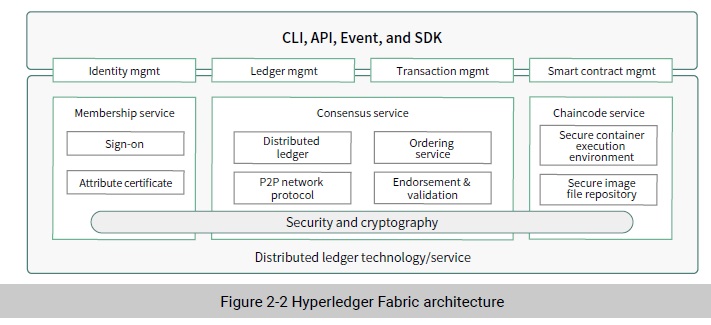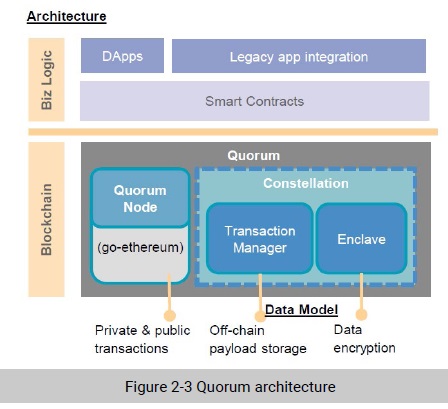
Current mainstream consortium blockchain platforms include Hyperledger, Quorum, and R3 Corda, which are described in detail in the following sections.
Hyperledger
The Hyperledger projectt was started in December 2015 by the Linux Foundation. It is intended to support the collaborative development and maintenance of a cross-industry, open, and distributed ledger technology platform and standard that enable any digital exchange with value, such as real estate contracts, energy trades, and marriage licenses, to be conducted and tracked securely and costeffectively.
Hyperledger’s projects include Blockchain Explorer, Fabric, and Sawtooth Lake, among which Fabric, as a basis for development of blockchain application or solutions, is the most fundamental one.
Hyperledger Fabric is an open-source, enterprise-grade technology platform for permissioned distributed ledger solutions specially designed for use in enterprise environments. Underpinned by a highly modular and configurable architecture, it supports pluggable consensus and pluggable identity management protocols (such as Lightweight Directory Access Protocol (LDAP) or OpenID Connect), key management protocols, and cryptographic libraries. Besides, it supports smart contracts authored in general-purpose programming languages (such as Java, Go, or Node.js) and leverages consensus protocols that do not require native cryptocurrency to incent costly mining or to fuel smart contract execution.
The Fabric platform is also permissioned. This means that a blockchain network can be operated under a governance model that is built off of the trust between participants who are known to one another, have been identified, and are often permissioned. The platform follows an execute – order – validate architecture.
These differentiated design features add up to make Hyperledger Fabric a good platform that performs well in transaction processing and transaction confirmation delays. Besides, it protects the privacy and confidentiality of transactions and implements smart contracts (called “chaincode” in Fabric).

Quorum
Quorum is an enterprise-grade, distributed ledger and smart contract platform built by J.P. Morgan, mainly designed to address special challenges of applying the blockchain technology in finance and other sectors. It is suitable for high-speed, high-throughput private transactions between organizations in a consortium. Quorum is an Ethereum-based distributed ledger protocol and so regarded as an enterprise edition of Ethereum. It provides private functions for transactions and contracts, supports various consensus mechanisms, provides permission management for networks and nodes, and delivers better performance. For these reasons, Quorum is considered a consortium blockchain platform.
The Quorum architecture has two layers: blockchain layer (lower) and business logic layer (upper), as shown in Figure 2.3.

R3 Corda
Corda is a distributed ledger platform launched by the R3 consortium. Founded in 2014, R3 leads a consortium of over 300 members. Initially, the consortium was made up of banks, with a view to exploring the possibility of using the blockchain technology for real-time financial transactions in global private networks. Today, R3 is expanding its focus from just financial scenarios to all areas where the blockchain technology can be potentially applied, including energy, health care, and supply chain management.
The Corda platform is especially suitable for regulated financial institutions. Inspired by the blockchain system, Corda has gradually abandoned many traditional blockchain design options unsuitable for the
financial sector. For example, unlike traditional blockchain platforms like Bitcoin and Ethereum, Corda does not use the global broadcast model that requires all nodes to be authenticated and all transactions to be recorded, but only requires participants of a transaction to have that transaction authenticated and recorded, thus greatly improving the throughput of transactions. Moreover, it resolves the dispute over whether the shared ledger can ensure the privacy of transaction data and accelerates the commercial application of the distributed ledger technology.
Corda provides a smart contract framework that supports the following key behaviors and has the following characteristics:
- Based on the existing legal framework and being compatible with existing and emerging regulations, Corda records and manages financial agreements between two or more identifiable participants and changes in other shared data.
- Has an inter-firm workflow design that features decentralized controls.
- Supports consensus between enterprises at the level of personal transactions rather than at the global system level.
- Supports incorporation of regulatory nodes and observer nodes of the supervisory nature.
- Verifies the validity of transactions only between transaction participants.
- Supports a number of consensus mechanisms.
- Records explicit links between legal documents of the natural language and smart contract code.
- Uses tools that comply with industry standards.
- Strictly restricts data access only to users with explicit authorization or logical access permissions.
To be continued.
